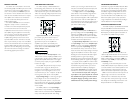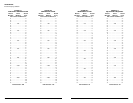
JL AUDIO 1000/1 19
“MY AMPLIFIER SHUTS OFF ONCE IN A WHILE, USUALLY AT HIGHER VOLUMES”
Check your voltage source and grounding point.The R.I.P.S. power
supply is rated to operate with source voltages between
11 - 14.5V. Shutdown problems at higher levels can occur
when the charging system voltage drops below 10-volts.These
dips can be of very short duration making them extremely
difficult to detect with a common DC voltmeter.To ensure
proper voltage, inspect all wiring and termination points. It is
also a good idea to improve the vehicle’s factory ground wire
and termination point. Grounding problems are the leading
cause of mis-diagnosed amplifier failures.
“MY AMPLIFIER TURNS ON, BUT THERE IS NO OUTPUT”
Check the input signal using an AC voltmeter to measure the
voltage from the source unit while an appropriate test tone
is played through the source unit (disconnect the RCA
cables from the amplifier prior to this test).The frequency
used should be in the range that is to amplified by the
channels being tested (example: 50 Hz for a sub bass
amplifier channel and 1 kHz for a full-range amplifier
channel). A steady voltage should be present at the output
of the RCA cables. If you are receiving a sufficient voltage
(between 0.2 and 8.0-volts), check to ensure that the
speaker wires are making a good connection with the metal
inside the amplifier.The connectors are designed to accept
up to an 8 AWG wire. If you are using significantly smaller
wire (14 AWG or smaller), you may have difficulty making
an adequate connection. In this case, you may find it
necessary to “fold” the wire over once (or twice!) so as to
make a solid connection. Make sure to strip the wire to
allow for a sufficient connection with the input or output
of the amplifier.
Check the output of the amplifier. Using the procedure explained in
the previous check item (after plugging the RCA cables back
into the amplifier) test for output at the speaker outputs of the
amplifier. Unless you enjoy test tones at high levels, it is a good
idea to remove the speaker wires from the amplifier while
doing this. Turn the volume up approximately half way.
5-volts or more should be measured at the speaker outputs.
This output level can vary greatly between amplifiers but it
should not be in the millivolt range with the source unit at half
volume. If you are reading sufficient voltage, check your speaker
connections as explained above.
(continued on next page)
“MY AMPLIFIER DOESN’T TURN ON”
Check to make sure there is +12V at the “Remote” connection of
the amplifier. In some cases, the turn-on lead from the source
unit is insufficient to turn on multiple devices and the use of a
relay is required. To test for this problem, jump the “+12V”
wire to the “Remote” terminal to see if the amplifier turns on.
If this does not work, proceed to the next step.
Check the fuse, not just visually but with a continuity meter. It is
possible for a fuse to have poor internal connections that
cannot be found by visual inspection. It is best to take the
fuse out of the holder for testing. If no problem is found
with the fuse, inspect the fuse-holder.
Check the “Signal Sensing” switch to make sure it is in the desired
position. If you are using a remote wire, this switch should be
in the “Off” position. If you are using the signal sensing
feature, make sure there is a full-range signal being sent to the
RCA inputs of the amplifier. If you continue to have trouble
with the signal sensing feature, test the amplifier’s ability to turn
on by throwing the “Signal Sensing” switch to the “Off”
position and jumping the “+12V” wire to the “Remote”
terminal. If this turns the amplifier on, check your input signal
and connections.
“I GET A DISTORTED / ATTENUATED SOUND COMING OUT OF THE SPEAKER(S)”
Check the speaker wires for a possible short, either between the
positive and negative or between a speaker lead and the
vehicle’s chassis ground. If a short is present you will
experience distorted and/or attenuated output.The
“Low Ω” light may also illuminate in this situation. It may be
helpful to disconnect the speaker wires from the amplifier
and use a different set of wires connected to a test speaker.
Check the nominal load impedance to verify that the amplifier is
driving a load between 1.5 - 4Ω. JLAudio monoblock
amplifiers have two “+” positive connections and two “–”
negative connections.This is to facilitate multiple speaker wiring.
The two positive and two negative connections are connected
in parallel inside the amplifier. Connecting two speakers,each
to one set of positive and negative terminals, will result in a
parallel speaker connection. In this case, each of the two loads
should have a nominal impedance between 3 - 8Ω.
Check the input signal and input signal cables to make sure signal is
present at the “Amplifier Input Section” and the cables are
not pinched or loose. It may be helpful to try a different set of
cables and/or a different signal source to be sure.
18 JL AUDIO 1000/1
APPENDIX D: TROUBLE SHOOTING















